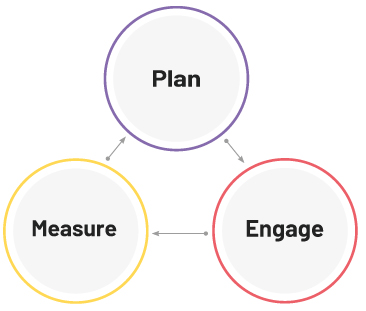Most organizations would agree that core business activities should follow a clear methodology (think logistics, production, accounting, etc.). But when it comes to the processes used in areas related to corporate social responsibility – such as community relations, land access and government affairs – many teams are still figuring it out as they go. This can lead to lost opportunities.
This article takes a deep dive into the stakeholder methodology advocated by best practices, including tools that make implementing this methodology easier.
In this article (< 7 min. read):
Why apply a stakeholder engagement methodology?
It’s not uncommon to see teams still managing their stakeholder information through a hodgepodge of emails, Excel spreadsheets, whiteboards and Post-It notes. Exactly how much valuable – or even sensitive data – is sitting in their inboxes, in their heads or in files in the cloud? The vast majority of these teams probably couldn’t tell you.
Managing large quantities of data in this manner is at best highly inefficient. It opens the door to information being misplaced, lost or stolen. This in turn can lead to oversights and poorly informed decision-making. It’s also highly problematic given the data privacy laws that are now in effect. These laws only promise to become stricter as time goes on.
Organizations with just a few stakeholders for a single project might be able to get away with an unstructured approach to managing stakeholder data and still be able to ensure data privacy and timely access to information.
But for organizations that have dozens of team members engaging with thousands of stakeholders on multiple projects in multiple sites, this approach to data management can quickly become very chaotic. Prompt and accurate reporting becomes extremely difficult, and measuring results, next to impossible. Specialized stakeholder management tools are almost always necessary at this level.
What is the best stakeholder engagement methodology?
Stakeholder engagement is a never-ending process. Companies must continually earn the trust and acceptance of their stakeholders. This ongoing cycle entails a number of steps, but they all fall under three key phases of stakeholder engagement:

Plan
The importance of building a solid stakeholder engagement plan cannot be overstated. It’s the difference between taking an informed and proactive approach to engaging with stakeholders vs. constantly reacting without fully understanding when, how and with whom you should be engaging – or why.
See the steps in building a solid stakeholder plan.
Engage
Only after you have a solid plan in place are you ready to engage with stakeholders. You know which team members need to engage with which stakeholders, in which manner, for what purpose, and how often. You probably also have a fairly good idea of what results you can expect from your engagement.
With a solid stakeholder plan in hand, you’ll know:
- Which method you should use to engage with specific stakeholders: door-to-door, email or public consultation, text message, grievance portal, etc.
- When exactly you should be engaging with these stakeholders.
- What your messaging should be for each individual stakeholder or stakeholder group.
- What tool you’ll be using to keep track all these engagements, including stakeholder feedback and grievances, along with follow-up and resolution, etc.
Measure
The only way engagement teams can be certain their engagement strategy is on-track, on-schedule and on-budget is by measuring the outcomes of their engagement efforts. However, this is where most teams fall short – usually because they don’t have the right stakeholder engagement measurement tools.
Most teams do a great job of engaging stakeholders, but few are able to show this in a concrete way. This is particularly true for teams working in public relations and government affairs, for whom a “good year” means that essentially, nothing happened.
Not being able to show the results of your efforts in quantitative terms can be problematic for a number of reasons. Here are just three big ones:
- A lack of regular, reliable and meaningful reporting makes it hard for head office to fully appreciate the value the team is building for the organization. In turn, this makes it harder for teams to justify their requests for budget and other resources.
- Subpar reporting hinders informed and strategic decision making.
- Poor reporting can also make it difficult to demonstrate compliance to external stakeholder requirements, putting project acceptance at risk.
At a very minimum, failing to properly measure stakeholder engagement will only create unnecessary work and stress, and essentially guarantee lost opportunities. Even more worrisome is the fact that poor reporting can lock organizations in a downward spiral of increasingly substandard outcomes.
Concrete improvements that can be achieved with the stakeholder engagement methodology
Improvement can mean different things to different teams within the organization. Here are some concrete examples for just a few internal teams involved in stakeholder engagement.
Types of improvements field agents look for
Field agents will gladly embrace any methodology or tool that lets them:
- Easily record stakeholder information so that there’s less manual data entry to do at the end of the day (and less risk of errors).
- Easily locate and access stakeholder information so that stakeholder questions can be answered intelligently on the fly, which will increase stakeholder trust (and prevent being blindsided).
- Not have to interrupt engagement activities whenever the boss needs a status update.
- Always know what colleagues are doing so that there’s no doubling efforts or oversights.
- Easily share insights and feedback with other team members, regardless of their location (and without having to bother them).
- See what happened on previous projects to avoid making the same mistake twice.
- Easily access the stakeholder information that’s being collected by other team members.
- Not have to worry about losing stakeholder information.
- Protect sensitive stakeholder information.
Types of improvements a director of community relations, land access, public affairs, etc. looks for
Most directors would give their left arm for any methodology or tool that gives them a real-time 360° view of:
- All past, current and planned projects.
- Key stakeholders for any given project, along with their stance, interest in and influence over the project.
- How different stakeholders are interrelated.
- All issues, grievances, communication and overall field activities related to assets, locations or any other geographical data.
- Which team member is doing what and when.
- What resources need to be allocated, when and where.
- What happened in previous projects to build on lessons learned and better predict costs, timelines and outcomes for new projects.
- Being able to quickly generate and configure reports based on the requester’s specific needs would also be a major gain.
Types of improvements the executive team looks for
An executive team is only as effective as the information it has at its disposal for decision making. Most management teams dream of being able to:
- Get status reports quickly to support timely decision making.
- Know that the information in reports is complete, reliable and up-to-date.
- Know that all stakeholder information is being diligently recorded and stored in a centralized repository, creating a lasting institutional memory that’s not dependant on any one team member, file or device.
- Know that stakeholder engagement is being done in a transparent and systematic way, demonstrating good governance.
- Know that the privacy of stakeholder data is adequately protected in compliance with data privacy laws.
- Break down information silos between departments to improve synergy and better support global objectives.
Types of improvements the IT team looks for
When a company decides to implement a new methodology for improving processes, often the first call is to the IT team – with a request for a tool that will enable this new methodology to be put into practice.
Most IT teams are strained beyond capacity and would jump at the chance to:
- Fully meet the requests of internal clients with minimal effort and delays.
- Avoid complex in-house software development or customization projects – especially when there’s no guarantee of successful implementation or clear roadmap for optimizing this investment over the long run.
- Outsource non-core activities and instead focus on activities that build value for the company.
- Recommend proven, purpose-built software that can meet all or most requirements right out of the box, with enough flexibility to quickly configure the software as needed to fill any gaps.
- Recommend software that is continuously supported and improved to keep pace with the organization’s evolving needs and best practices over time.
- Recommend software that’s developed, managed, supported and maintained by a dedicated team with specialized expertise on that specific software, including:
- Software implementation and user onboarding, training & ongoing support.
- 24/7 infrastructure, network and application monitoring and maintenance.
- Compliance with operational policies and processes.
- Compliance with data availability, security and privacy requirements.
That’s a pretty long wish-list to satisfy for any change management initiative – and this covers just a few key groups within an organization.
But that’s exactly what a specialized tool like Borealis stakeholder engagement software can do, right out of the box.

Let us show you how Borealis Stakeholder Management Software can help your team work more efficiently.
Software that supports the best stakeholder engagement methodology
Borealis stakeholder engagement software has been designed to make it easier for teams to apply the proven stakeholder methodology of PLAN – ENGAGE – MEASURE in a seamless manner. Rather than requiring teams to reinvent their existing work methods, it supports and strengthens them so that these teams can spend more time on:
- Planning their engagement strategies based on a clear understanding of the stakeholder landscape.
- Engaging stakeholders in a more informed and meaningful manner to better build trust and acceptance.
- Closely tracking all efforts and outcomes to better adapt to unexpected changes and shorten the path to securing social license to operate.
- Demonstrating a culture of compliance and good governance to build a reputation of good corporate citizenship.
A specialized stakeholder management platform like Borealis makes it much easier for teams to follow these best practices in stakeholder engagement.
The best way to appreciate how Borealis software can improve your stakeholder engagement is with a demo. Let us give you a free customized demo and we can discuss your specific challenges and objectives.






